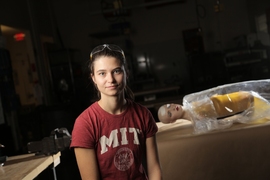Dust, dirt, bacteria, flies — these are just some of the many contaminants surgeons need to worry about when operating in the field or in hospitals located in developing nations. According to a 2015 study in The Lancet, 5 billion people don’t have access to safe, clean surgical care. Graduate student Sally Miller ’16 is hoping to change that with a product called SurgiBox.
“The idea of SurgiBox is to take the operating room and shrink it down to just the patient’s size,” Miller explains. “Keeping an entire room clean and surgery-ready requires a lot of resources that many hospitals and surgeons across the globe don’t have.”
Upon starting her master’s degree in the Department of Mechanical Engineering, where she also received her bachelors, Miller connected with Daniel Frey, professor of mechanical engineering and faculty research director of MIT’s D-Lab. Frey had been working on the concept of SurgiBox with Debbie Teodorescu, the company’s founder and CEO, who graduated from Harvard Medical School and acted as a D-Lab research affiliate. Having just won the Harvard President’s Challenge grant of $70,000, the SurgiBox team was looking for a mechanical engineering graduate student who could help enhance the product’s design.
“We were looking for a way to accelerate the project,” explains Frey, who also serves as Miller’s advisor. “At MIT, grad students can really deepen a project and move it forward at a faster pace.”
Enter Miller, who took on the project as her master’s thesis. “The first thing I did was assess the design they already had, but use my mechanical engineering lens to make the product more affordable, more usable, and easier to manufacture,” Miller explains.
Miller found inspiration in 2.75 (Medical Device Design). For the class project, she visited the VA Medical Center, where she watched a pacemaker surgery. During the surgery, doctors placed an incise drape — an adhesive, antimicrobial sheet infused with iodine — on the site of the incision.
“Watching the surgeons that day I realized, ‘Oh, I can use this adhesive drape idea for SurgiBox,’” Miller says.
In addition to incorporating adhesive drapes at the point of incision, Miller has redesigned the structure of SurgiBox. The original design had a rectangular frame that sealed to the patient at the armpit and waist. The frame held up a plastic, tent-like enclosure with a fan and high-efficiency particulate air (HEPA) filter that removes 99.997 percent of contaminants. Miller realized, to make SurgiBox more portable and cost effective, she had to get rid of the frames. With her new design, SurgiBox now consists of an inflatable tent; the outward pressure from the HEPA-filtered air gives the surgical site its structure.
This structural change marked a turning point in SurgiBox’s development. “Now the patient doesn’t have to be in the SurgiBox. Rather, the SurgiBox is on them,” Frey explains. “I thought that was a big breakthrough for us.”
Teodorescu agrees. “Sally is stunningly capable at both manual and digital forms of technical drafting,” she says. “Because of her designs, a key part of SurgiBox now fits into a Ziploc bag.” This latest iteration of SurgiBox now meets the same germ-proof and blood-proof standard as surgical gowns used by doctors treating Ebola patients.
The next step for the SurgiBox team is user testing. In addition to continuing particle testing, the team will partner with local Boston-area hospitals to test the ergonomics of the design and ensure it aligns with surgical workflows. After that, the team will test its efficacy at partner hospitals in developing nations where the technology is most needed.
As for Miller, after graduating with her masters in January she is hoping to start a career in product design. “Working on SurgiBox during my masters and in classes like 2.009 (Product Engineering Processes) in my undergraduate classes gave me hands-on experience in creating a product with real-world application,” Miller says. “I’m open to working on products in a number of fields and am excited to see what my future holds after MIT.”











